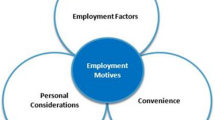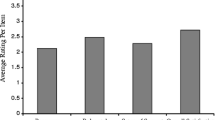Abstract
This paper examines how individuals in the unique, doubly marginal, environment of prison-based college faculty draw from both component professions to construct positive educational experiences. Based on qualitative interviews and participant observation, the processes by which correctional higher educators construct experiences are explored. Job satisfaction is constructed from two fabrics, social compensations (of interactional and intimate forms) and structural compensations. Balanced against the experiential rewards are the mitigating elements of interactional, institutional and organizational stresses. The integration of compensations and stresses are shown to form the foundation upon which positive professional experiences are constructed.
Similar content being viewed by others
References
Anderson, D. (1977). “Needed: Teacher Training Programs for Correctional Education.”Journal of Correctional Education, 28:6–7.
Arshad, C. (1975).A Descriptive Analysis of Selected Personal, Social and Professional Needs of the Teaching Staff in the State of Ohio’s Correctional Institutions. Unpublished doctoral dissertation, University of Cincinnati.
Blackburn, F.S. (1981). “The Relationship Between Recidivism and Participation in a Community College Program for Incarcerated Offenders.”Journal of Correctional Education, 32:23–25.
Cares, R.C.& R.T. Blackburn. (1978). “Faculty Self-Actualization: Factors Affecting Career Success.”Research in Higher Education, 9:123–136.
Cheek, F. & M. Miller. (1983). “The Experience of Stress for Corrections Officers.”Journal of Criminal Justice, 11:105–120.
Cioffi, F. (1981). “Teaching College Humanities Courses in Prison.”Alternative Higher Education, 6:49–59.
Clendenen, R.J., J.R. Ellingston & R.J. Severson. (1979). “Project Newgate: The First Five Years.”Journal of Crime & Delinquency, 25:55–64.
DeGraw, D. (1987). “A Study of Correctional Educators in Adult Correctional Institutions.”Journal of Correctional Education, 38:18–20.
Gerstein, L.H., C.G. Topp & G. Correll. (1987). “The Role of the Environment and Person When Predicting Burnout Among Correctional Personnel.”Criminal Justice & Behavior, 14:352–369
Gmelch, W.H., N.P. Lovrich & P.K. Wilke. (1984). “A National Study of Stress Among University Faculty Members.”Phi Delta Kappan, January:367.
Gmelch, W.H., P.K. Wilke & N.P. Lovrich. (1986) “Dimensions of Stress Among University Faculty.”Research in Higher Education, 24:266–286.
Guenther, A. & M. Guenther. (1974). “Screws and Thugs.”Society, 11:42–50.
Hawke, S.D. & J. Ritter. (1988). “Teaching Biology Behind Prison Walls.”Journal of College Science Teaching, 18:22–25.
Jacobs, J. (1978). “What Prison Guards Think: A Profile of the Illinois Force.”Journal of Crime & Delinquency, 24:185–196.
Jacobs, J. & H.G. Retsky. (1975). “Prison Guard.”Urban Life, 4:5–29.
Knepper, P. (1989). “Selective Participation, Effectiveness and Prison College Programs.”Journal of Offender Counseling, Services & Rehabilitation, 14:109–135.
Lindquist, C.A. & J.T. Whitehead. (1986). “Burnout, Job Stress and Job Satisfaction Among Southern Correctional Officers: Perceptions and Causal Factors.”Journal of Offender Counseling, Services & Rehabilitation, 10:5–25.
Loeffler, C.A., T.C. Martin, D.L. Henderson & R. McNeese. (1986). “Anatomy of a Prison Educator: A Profile of Correctional Educators in Windham School System, Huntsville, Texas.”Journal of Correctional Education, 37:24–29.
McCracken, G. (1988).The Long Interview. Beverly Hills, CA: Sage.
McKeen, R.B. (1983). “In-Service Training and Staff Development for Correctional Educators.”Journal of Correctional Education, 34:12–14.
O’Neil, M. (1990). “Correctional Higher Education: Reduced Recidivism?”Journal of Correctional Education, 41:28–31.
Parker, E.A. (1990). “The Social-Psychological Impact of a College Education on the Prison Inmate.”Journal of Correctional Education, 41:140–146.
Pearson, D.A. & R.E. Seiler. (1983). “Environmental Satisfiers in Academe.”Higher Education, 12:35–47.
Regoli, R.M., E.D. Poole & J.L. Schrink. (1979). “Occupational Socialization and Career Development: A Look at Cynicism Among Correctional Institution Workers.”Human Organization, 38:183–187.
Roundtree, G.A., D.W. Edwards & S.H. Dawson. (1982). “The Effects of Education on Self-Esteem of Male Prison Inmates.”Journal of Correctional Education, 32:12–18.
Schlacter, P. (1980).Concept of Self and Perceived Stress: A Study of Correctional Officers. Unpublished doctoral dissertation, Ohio State University.
Schumacker, R.E., D.B. Anderson & S.L. Anderson. (1990). “Vocational and Academic Indicators of Parole Success.”Journal of Correctional Education, 41:8-l3.
Scott, J.E. (1976).A Perceptual Model of a Correctional Educator’s Education Program. Unpublished doctoral dissertation, Ohio State University.
Smith, N.E. (1988).Impression Management in the Prison. Unpublished doctoral dissertation, Ohio State University.
Stein, M. (1989). “Teaching Deviance to Deviants: The Prison Classroom Experience.”Free Inquiry in Creative Sociology, 17:185–191.
Thorpe, T., D. MacDonald & G. Bala. (1984). “Follow-up Study of Offenders Who Earn College Degrees While Incarcerated in New York State.”Journal of Correctional Education, 35:86–88.
Toupin, L. (1988). “Practical Experience and Instructional Approach by Teachers in Quebec Federal Penitentiaries.”Journal of Correctional Education, 39:108–113.
Wilson, R.C., J.G. Gaff, E.R. Dienst, L. Woods & J.L. Bavry. (1975)College Professors and their Impact on Students. New York: John Wiley.
Author information
Authors and Affiliations
Rights and permissions
About this article
Cite this article
Tewksbury, R. On the margins of two professions: Job satisfaction and stress among post-secondary correctional educators. AJCJ 18, 61–77 (1994). https://doi.org/10.1007/BF02887639
Issue Date:
DOI: https://doi.org/10.1007/BF02887639




